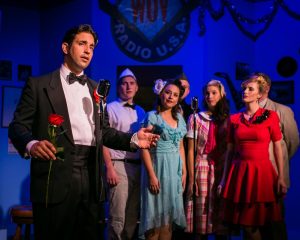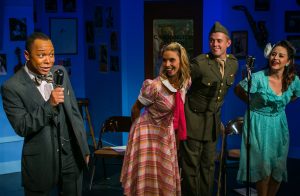Lack of Ensemble, Vision Hobble NVA’s ‘Radio Hour’
There’s something especially appropriate about a laxative commercial with a lawyer as the central character (just sayin’). If playwright Walton Jones had that analogy in mind when he wrote the ad into The 1940s Radio Hour, he was on the right track. In fact, the show, current holiday offering out of New Village Arts, has its heart in exactly that place as Jones, a UCSD theater professor emeritus, creates some interesting character studies set during December in 1942 New York.
His sketches invite the suggestion of a certain nervous energy for the country’s future — we were a year into the nation’s involvement in the Second World War and its wholesale effort to dispatch a band of despots who would shape the globe to their ends. American life went by in slow motion, with the smallest conservation effort or candlelight vigil writ exponential on the popular stage.
But the possibility of a subjugated world deserves an equally colossal response, especially amid the holiday climate — and in that regard, this Radio Hour doesn’t always hold up. It has its charms and its positive qualities, but the directorial effort often overlooks the enormous subtext that gives the script its life.

Johnny Cantone (Eric M. Casalini, left) is joined by a cast of thousands in New Village Arts’ ‘The 1940s Radio Hour.’ Photos by Shaun Hagen, Top Shelf Photo.
Jones chose a lateral development for this show, forgoing a plot in favor of a motley mix of stock characters. Smarmy lounge lizard and Rat Pack hodad Johnny Cantone (Eric M. Casalini) is among the guests, flanked by chanteuse Ginger Brooks (Marlene Montes, who does a nice job with the torch piece “Daddy”), board op and company cheerleader Lou Cohn (a very good Li-Anne Rowswell) and Pops Bailey (Jack Missett), the obligatory station utilityman who’s been around since 1754 and who’s forgotten more about the staff members than they know about themselves.
But even as they’re in good voice (“Ain’t She Sweet,” “Jingle Bells,” “Boogie Woogie Bugle Boy”), the performers often look underrehearsed, succeeding in their individual skin only to fall shy in creating a culture of ensemble. Whlie part of that is on Jones (not nearly enough references to the war effort, a token serviceman and his token girlfriend, a badly truncated turn at A Christmas Carol), director Dana Case and her assistant Dane Liberatore either don’t see the possibilities for illustration or don’t trust Jones’ writing to follow through on them.
(The sound effects table) should be a prime center of attention in this radiocentric environment.
Some of the subtext is crystal-clear (watch piano man Zoot Doubleman (music director Tony Houck) applaud one of Ginger’s numbers; no mistaking where his heart lies), while most of it either languishes (Cantone’s come-on to singer Ann Collier) or waxes inelaborate (Bailey’s follies as a dime-store bookie). The potential for bits of business is all over this script, and the preponderance is unexplored — not unlike the state of the sound effects table, situated way too far toward the stage-left sighline on Kelly Kissinger’s underlit set. It and its contents should be a prime center of attention in this radiocentric environment.
Fedddington has been freaking out with these shows at other stations for years, and Kevane La’Marr Coleman illustrates him fairly well through his voice and body. Neal Tilden and Wally Fergusson (AJ Knox and Jake Bradford) might as well be in a buddy play of their own; their appeal is certainly authentic, and Knox’s impressions are a nice touch to his insouciant character.

Clifton A. Feddington (Kevane La’Marr Coleman, left) trades yuks with Connie Miller, BJ Gibson and Ginger Brooks (Daniella Levas, Zackary Scot Wolfe and Marlene Montes) as this year’s radio hour gets under way.
As I left the theater, I overheard several patrons shower praises — the songs, they said, were the very tunes they’d grown up with, and for them, the holiday setting added to the piece’s appeal. That’s the demographic that this story will draw, and so much the better. The direction needs a bigger vision, but the core audience will find a lot to like in the song list and in the performances, especially those of Missett, Coleman and Knox.
This review is based on the matinee performance of Dec. 4. The 1940s Radio Hour runs through Dec. 31 at New Village Arts, 2787 State St. in Carlsbad. $45-$48. newvillagearts.org, 760-433-3245.

Martin Jones Westlin, principal at editorial consultancy Words Are Not Enough and La Jolla Village News editor emeritus, has been a theater critic and editor/writer for 25 of his 47 years…
More…


